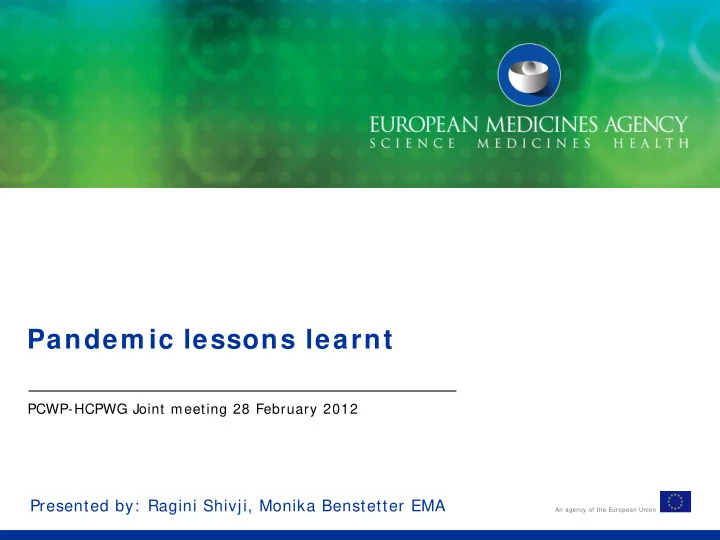

Pandem ic lessons learnt PCWP-HCPWG Joint meeting 28 February 2012 Presented by: Ragini Shivji, Monika Benstetter EMA An agency of the European Union
Overview of presentation Background & Objective European regulatory system for pandemic vaccines- mock up concept to the approval of the pandemic vaccines Key lessons learned* Communications lessons learnt and way forward * Full lessons learned published http: / / www.ema.europa.eu/ docs/ en_GB/ document_library/ Report/ 2011/ 04/ WC500105820.pdf 2
Background Agency pandemic activities restricted to our remit- e.g. who can be vaccinated not who will be vaccinated Agency preparedness activities since 2003. 2009 pandemic Agency lessons learnt exercise 2010-2011 Communications identified as key area for improvement- both during preparedness and during a pandemic Objective Harness the experience of this group to revise the pandemic communications strategy 3
W hat is a Mock-Up Pandem ic Vaccine? A Mock-up vaccine is a vaccine containing viral antigen(s) to which humans are immunologically naïve, e.g. H9N2 / H5N1. Scientific data for a mock-up vaccine are relevant for the pandemic vaccine: Manufacturing and quality data Clinical experience in naïve population Evaluation of novel concepts prior to a pandemic e.g. use of adjuvants with the objective of increasing available doses, establishment of dosing schedule The concept is based on the system used annually for seasonal flu vaccines but was poorly understood 4 during the pandemic.
Mock-up Strategy Prior to pandem ic: Mock-up Pandem ic vaccine ( Not MA for use in pandem ic) Marketing Marketing Quality, safety, efficacy Authorisation Authorisation Core dossier using a strain e.g. H5N1 (MA) – – same strain same strain (MA) (H5N1) (H5N1) Pandem ic strikes: Mock-up is am ended for use in pandem ic Supplementary quality data Pandemic Pandemic on the new strain, e.g. H1N1 Vaccine MA Vaccine MA (H1N1) (“quality variation” to the MA) (H1N1) Additional Data during pandemic a) Follow-up Clinical data b) Risk Management Plan 5
Lessons learned: Key points ( 1 ) Mock up vaccines have allowed incorporation of pandemic strains within 5 months of identification of novel virus. Studies ultimately confirmed high level of effectiveness of these products. Availability of an authorised brand new vaccine during a pandemic will inevitably be late i.e. after pandemic start. Need to reduce time to availability further. Expect uncertainty with a new influenza pandemic virus. More research into new technologies, influenza disease, serology assays etc. required. More flexibility therefore needed in future to cover different pandemic scenarios (e.g. more preparedness information on different strains, severity, target population etc.). Although industry, international and EU liaison worked well in this pandemic there are certainly areas for improvement which will enhance the pandemic response both at the EU and the international level 6
Lessons learned: Key points ( 2 ) Need to consider all mechanisms that will further accelerate time to availability of pandemic vaccines e.g. clinical trial data, availability of reagents for potency testing/ alternative potency testing methods. Consider standardising clinical trial protocol approvals and facilitating ethics approvals. Improvements to further strengthen pharmacovigilance systems in the EU necessary, particularly the infrastructure and funding for large safety and effectiveness studies to complement data obtained from companies. Further work on immunisation and pregnancy registries also needed. Need for better future strategy on communication especially with professionals and public and critically for certain issues e.g. difficulties with decision making during periods of uncertainty (How severe is the pandemic/ one-dose or two doses of a vaccine needed?), use of adjuvants, thiomersal, use of vaccines in children and pregnancy, general vaccine uptake, narcolepsy issue). 7
Com m unications lessons learned ( 1 ) Provision of inform ation Much effort and resources were dedicated to ensuring that the most up-to-date product information for healthcare professionals and patients was available on the EMA’s website. However, there is doubt to what extent the information provided was used by patients and healthcare professionals. Dissemination systems that give easier access to this information for patients and healthcare professionals are needed. 8
Com m unications lessons learned ( 2 ) W orking w ith the m edia The media played an important part in the pandemic and the Agency received a large amount of requests to participate in media interviews. The Agency should ensure that it has a pool of appropriately trained spokespersons available who can talk on behalf of the Agency to the media and who can explain in simple terms the activities of the Agency. 9
Com m unications lessons learned ( 3 ) Healthcare professionals - a key stakeholder group Healthcare professionals were identified as key to disseminating reliable information about vaccines and antivirals. The Agency should work closely with its working group of healthcare professionals to explore particular needs and concerns of healthcare professionals and to address those in designing future communications programmes. . 10
How to im prove com m unications during crisis? • What kind of information would you have liked to obtain from us in the previous pandemic? • When? What frequency? Which format? • What information was missing? • Where did you turn for information? Where did you expect information to come from? • Did you use the Agency's website as a reference site for the latest updated product information? • Did your organisation disseminate information about e.g. vaccines or antivirals to national organisations/ individual healthcare professionals/ patients? 11
Next steps for Com m unications Update of the pandemic communications strategy Discuss and test with Healthcare Professionals WG Explore other areas of actual involvement in pandemic activities such as participation in Scientific Advisory Groups, involvement in labelling, medication errors, etc, Explore possibilities of involvement of vaccines communications experts 12
Concluding Rem arks • The Agency facilitated the first EC centralised authorisations of pandemic vaccines within 5 months of identification of a novel human influenza virus. • ECDC-coordinated studies in the pandemic found high effectiveness for vaccines containing A(H1N1)2009. Other observational studies have confirmed this. • Inevitably, there are a number of lessons learnt which the Agency is working through. 13
Recommend
More recommend